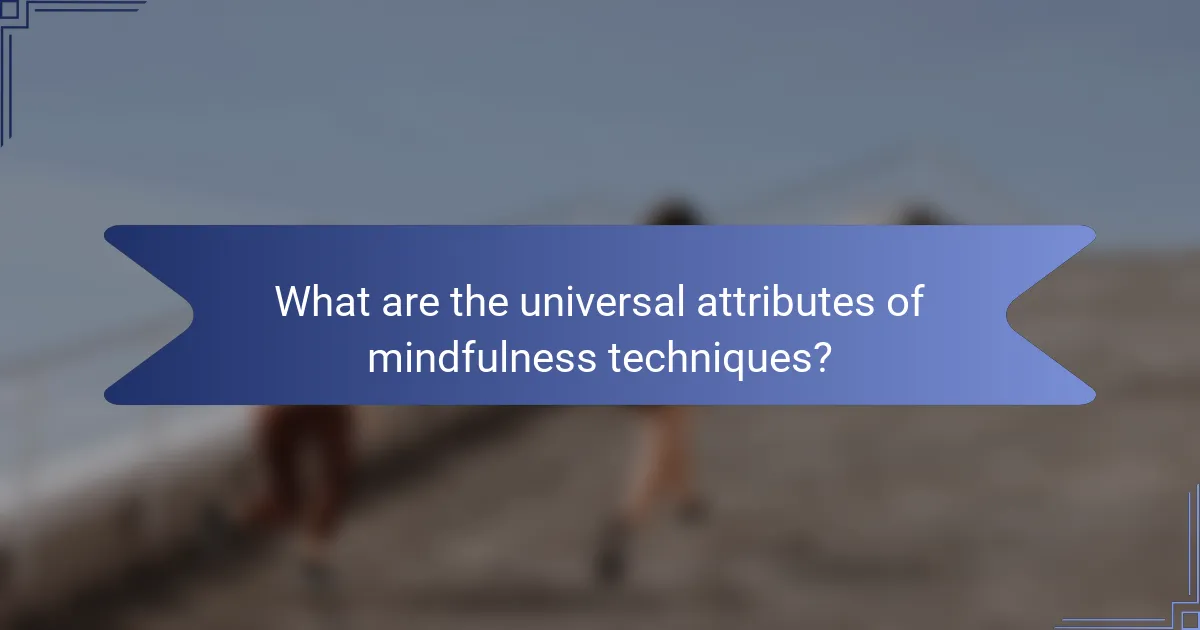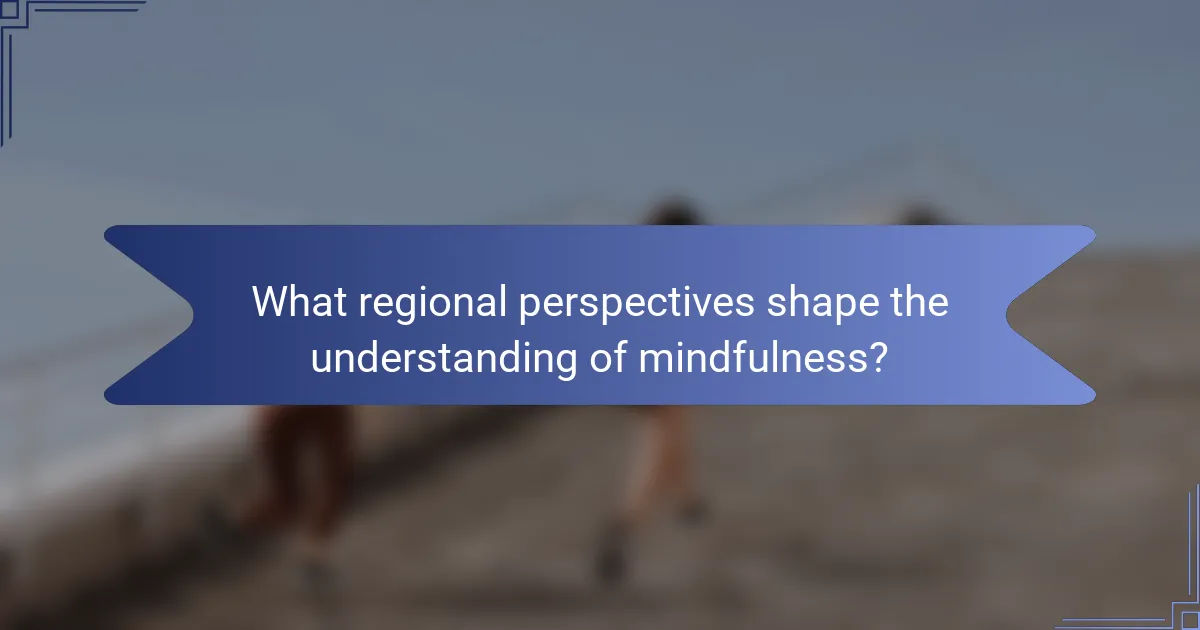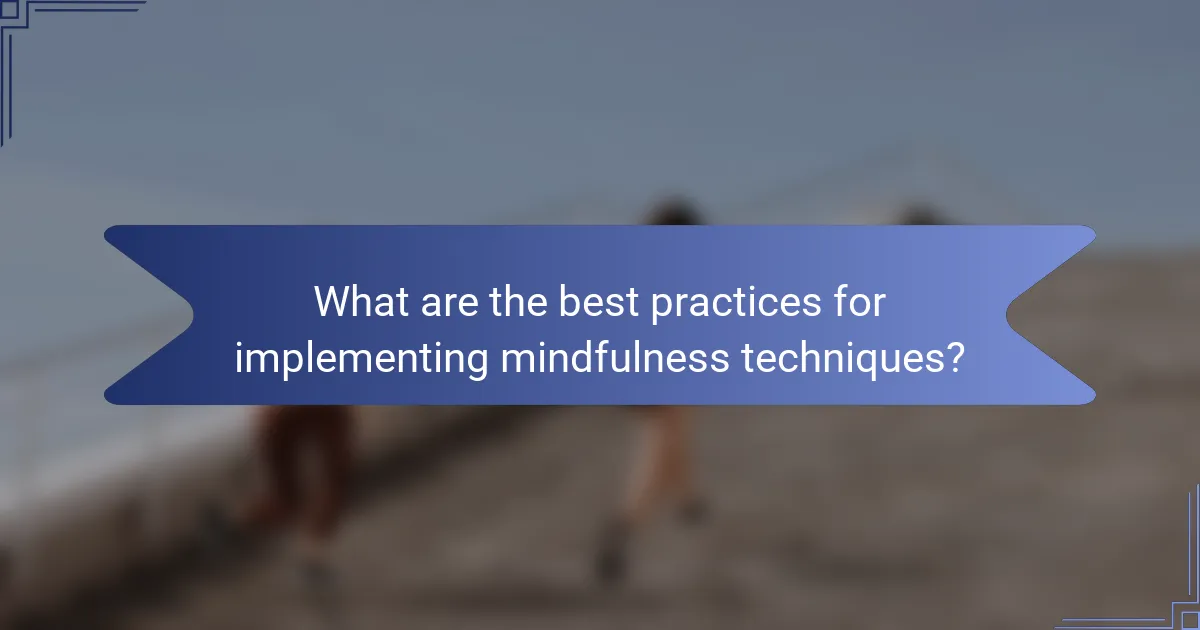Mindfulness techniques are effective tools for reducing stress and building emotional resilience. This article explores practices such as meditation, deep breathing, and body scanning. It examines how these methods enhance self-awareness and promote relaxation. Additionally, it highlights the cultural influences on mindfulness and offers practical tips for integrating these techniques into daily life.

What are the core mindfulness techniques for stress reduction and emotional resilience?
Mindfulness techniques for stress reduction and emotional resilience include practices such as meditation, deep breathing, and body scanning. These methods enhance self-awareness and promote relaxation.
Meditation encourages focused attention, which helps in reducing anxiety and improving emotional stability. Deep breathing exercises activate the body’s relaxation response, lowering stress levels effectively. Body scanning involves mentally observing sensations throughout the body, fostering a connection between mind and body.
Regular practice of these techniques can lead to long-term benefits, such as improved mood and increased resilience against stressors. Engaging in mindfulness can also enhance overall well-being, making it a valuable practice for anyone seeking emotional balance.
How does mindfulness impact stress levels?
Mindfulness significantly lowers stress levels by promoting relaxation and emotional regulation. Techniques such as meditation and deep breathing activate the body’s relaxation response, reducing cortisol levels. Research shows that regular mindfulness practice can lead to a 30% decrease in perceived stress. Additionally, mindfulness enhances emotional resilience, enabling individuals to cope better with challenging situations. By fostering present-moment awareness, mindfulness helps individuals detach from stressors, leading to improved mental clarity and emotional stability.
What role does mindfulness play in emotional resilience?
Mindfulness enhances emotional resilience by promoting awareness and acceptance of thoughts and feelings. It helps individuals manage stress and respond to challenges with greater calmness. Techniques such as meditation and deep breathing can reduce anxiety and improve emotional regulation. Research indicates that regular mindfulness practice can lead to significant improvements in mental well-being and resilience.

What are the universal attributes of mindfulness techniques?
Mindfulness techniques universally share attributes that enhance stress reduction and emotional resilience. These techniques promote present-moment awareness, encourage non-judgmental observation, and foster emotional regulation. Common practices include meditation, deep breathing, and body scanning, which collectively improve mental clarity and reduce anxiety. Root attributes involve cultivating awareness and acceptance, while unique attributes may include specific methods tailored to individual needs. Rare attributes could encompass cultural variations in practice, such as Zen meditation or mindfulness in nature.
What are the common forms of mindfulness practice?
Mindfulness practices commonly include meditation, body scans, mindful breathing, and mindful walking. Each technique enhances stress reduction and emotional resilience by promoting present-moment awareness.
Meditation can take various forms, such as focused attention or loving-kindness practices. Body scans involve systematically focusing attention on different body parts to release tension. Mindful breathing emphasizes awareness of breath patterns, while mindful walking encourages connection with the environment.
These techniques vary in approach but share the core attribute of fostering mindfulness, which is crucial for emotional well-being. Regular practice can lead to significant improvements in stress management and overall mental health.
How can breathing exercises be applied for stress relief?
Breathing exercises can significantly reduce stress by promoting relaxation and mindfulness. These techniques activate the parasympathetic nervous system, which lowers heart rate and calms the mind.
One effective method is diaphragmatic breathing, which involves inhaling deeply through the nose, allowing the diaphragm to expand, and exhaling slowly through the mouth. This exercise can be practiced for five to ten minutes daily to enhance emotional resilience.
Additionally, incorporating guided imagery with breathing can deepen relaxation. Visualizing a peaceful scene while focusing on breath patterns helps to further alleviate stress.
Regular practice of these techniques can lead to long-term benefits, including improved mood and greater emotional stability.
What is the significance of body scanning in mindfulness?
Body scanning in mindfulness enhances self-awareness and emotional regulation. This technique allows individuals to connect with their bodily sensations, fostering relaxation and reducing stress. By focusing attention on different body parts, practitioners can identify areas of tension and release them, promoting a sense of calm. Research indicates that regular practice can lead to improved emotional resilience, helping individuals manage anxiety and stress more effectively. Furthermore, body scanning cultivates a unique attribute of mindfulness by integrating physical awareness with mental clarity, creating a holistic approach to well-being.
What are the benefits of regular mindfulness practice?
Regular mindfulness practice enhances stress reduction and emotional resilience. It promotes relaxation, improves focus, and increases self-awareness. Studies indicate that mindfulness can decrease anxiety levels by up to 30%. Additionally, it fosters emotional regulation, enabling better responses to stressors. Practicing mindfulness regularly can lead to long-term mental health benefits, creating a more balanced emotional state.

What unique attributes set certain mindfulness techniques apart?
Certain mindfulness techniques are distinguished by their unique attributes, which enhance their effectiveness for stress reduction and emotional resilience. Techniques like mindfulness meditation, body scanning, and mindful breathing offer distinct approaches that cater to individual preferences and situations.
Mindfulness meditation, for instance, emphasizes present-moment awareness, fostering a deep connection with thoughts and feelings. Body scanning uniquely promotes physical awareness by encouraging practitioners to focus on different body parts, enhancing relaxation. Mindful breathing stands out for its simplicity and accessibility, making it easy to integrate into daily routines.
These unique attributes not only differentiate the techniques but also allow individuals to choose methods that resonate with their personal experiences and emotional needs.
How do guided visualizations enhance emotional resilience?
Guided visualizations significantly enhance emotional resilience by promoting relaxation and self-awareness. These techniques help individuals visualize positive outcomes, reducing stress and anxiety. Research indicates that regular practice can lead to improved coping strategies and emotional regulation. By fostering a deeper connection with one’s thoughts and feelings, guided visualizations empower individuals to face challenges with greater confidence and adaptability.
What differentiates mindfulness-based stress reduction programs?
Mindfulness-based stress reduction programs differ through their structured approach, focusing on meditation, body awareness, and cognitive techniques. These programs emphasize experiential learning and self-reflection, fostering emotional resilience. Unique attributes include the integration of mindfulness practices tailored to individual needs, duration, and group dynamics, enhancing personal growth.

What rare attributes exist within mindfulness techniques?
Rare attributes within mindfulness techniques include the integration of neurofeedback, the use of virtual reality environments, personalized meditation approaches, and the incorporation of biofeedback mechanisms. These unique traits enhance the effectiveness of mindfulness practices, allowing for tailored experiences that address individual stressors and emotional needs.
What unique approaches are used in mindfulness for trauma recovery?
Mindfulness techniques for trauma recovery often include unique approaches such as body awareness practices, breath-focused meditation, and guided imagery. These methods enhance emotional resilience by fostering a safe internal environment. Body awareness helps individuals reconnect with their physical sensations, while breath-focused meditation promotes relaxation and present-moment awareness. Guided imagery allows for the visualization of safe spaces, aiding in the processing of traumatic experiences. These tailored techniques address the unique needs of trauma survivors, making mindfulness a powerful tool for recovery.
How do cultural variations influence mindfulness practices?
Cultural variations significantly shape mindfulness practices by influencing techniques and interpretations. For instance, Eastern traditions often emphasize meditation and breath awareness, while Western approaches may integrate cognitive behavioral elements. This diversity enriches techniques, enhancing emotional resilience across different populations. Moreover, cultural values dictate the communal or individual focus of mindfulness, affecting its application in daily life. Understanding these variations allows practitioners to tailor mindfulness strategies effectively, ensuring relevance and effectiveness in diverse contexts.

What regional perspectives shape the understanding of mindfulness?
Cultural and regional perspectives significantly influence the understanding of mindfulness. In Western contexts, mindfulness often emphasizes psychological benefits, such as stress reduction and emotional resilience. In contrast, Eastern traditions, particularly Buddhism, view mindfulness as a spiritual practice intertwined with ethical living and awareness.
Regional practices vary; for instance, in Japan, mindfulness practices integrate Zen principles, focusing on simplicity and nature. In India, mindfulness may be linked to yoga and meditation, promoting holistic well-being. These diverse interpretations shape how mindfulness techniques are applied to stress management and emotional health across cultures.
Research indicates that cultural background impacts mindfulness practice effectiveness. For example, studies show that Western practitioners may prioritize cognitive aspects, while Eastern practitioners focus on experiential awareness. This distinction highlights the unique attributes of mindfulness across different regions, contributing to a richer understanding of its applications in stress reduction and emotional resilience.
How is mindfulness perceived in different cultures?
Mindfulness is perceived differently across cultures, influencing techniques for stress reduction and emotional resilience. In Western cultures, mindfulness often emphasizes individual well-being and therapeutic applications, focusing on mental health benefits. In contrast, Eastern cultures view mindfulness as a holistic practice integrated into daily life, promoting harmony and community connection.
For example, in Buddhism, mindfulness is a path to enlightenment, while in Western psychology, it is a tool for managing anxiety. These cultural perspectives shape the techniques employed, such as meditation practices in Eastern traditions versus cognitive behavioral approaches in Western contexts.
Additionally, the unique attribute of mindfulness in Indigenous cultures may include spiritual connections to nature, emphasizing community and environmental awareness. As a result, mindfulness practices can vary significantly, reflecting diverse values and beliefs surrounding stress management and emotional health.
What local adaptations of mindfulness techniques exist?
Various local adaptations of mindfulness techniques exist, tailored to cultural contexts. Examples include Zen meditation in Japan, which emphasizes sitting still and observing thoughts, and Vipassana in Southeast Asia, focusing on insight through breath awareness. In Western cultures, Mindfulness-Based Stress Reduction (MBSR) combines mindfulness practices with therapeutic elements, promoting emotional resilience. Additionally, indigenous practices, such as Native American sweat lodge ceremonies, incorporate mindfulness through community and nature connection. These adaptations reflect unique cultural values while maintaining the core principles of mindfulness for stress reduction.

What are the best practices for implementing mindfulness techniques?
To effectively implement mindfulness techniques, focus on consistency, simplicity, and integration into daily life. Start by setting aside dedicated time each day for mindfulness practices. Use guided meditations or mindfulness apps to enhance focus. Incorporate mindfulness into routine activities, such as eating or walking, to reinforce awareness. Track progress and adjust techniques based on personal experiences to cultivate emotional resilience and reduce stress.
How can one effectively incorporate mindfulness into daily life?
To effectively incorporate mindfulness into daily life, practice techniques such as mindful breathing, body scans, and gratitude journaling. These methods enhance stress reduction and emotional resilience.
Mindful breathing involves focusing on your breath for a few minutes daily, promoting relaxation. Body scans encourage awareness of physical sensations, helping identify areas of tension. Gratitude journaling fosters positive thinking by reflecting on daily blessings.
As a result, these techniques can lead to improved emotional health and a more balanced life. Regular practice can enhance overall well-being, making mindfulness an integral part of daily routines.
What common mistakes should be avoided when practicing mindfulness?
To practice mindfulness effectively, avoid distractions, unrealistic expectations, and self-judgment. Focus on the present moment without trying to control thoughts or emotions. Establish a consistent routine, but be flexible with time and techniques. Prioritize self-compassion and patience, as progress takes time.
What expert insights can enhance mindfulness practice?
Incorporating expert insights can significantly enhance mindfulness practice. Techniques such as focused breathing, body scanning, and mindful observation cultivate present-moment awareness. Research indicates that consistent practice can reduce stress by up to 30% and improve emotional resilience, enabling individuals to better manage challenges. Engaging in group mindfulness sessions also fosters community support, enhancing motivation and accountability.